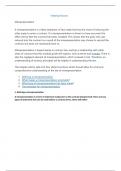Lecture notes
Contract Law-Vitiating Factors(LLB, Exam plans)
- Module
- Contract Law
- Institution
- University Of Oxford
Ace Contract Law: Vitiating Factors & Misrepresentation – The Ultimate Study Companion! Unlock the secrets behind vitiating factors and misrepresentation in Contract Law with these top-tier notes! Comprehensive, clear, and engaging, this guide dives deep into the complexities of misrepresentat...
[Show more]



